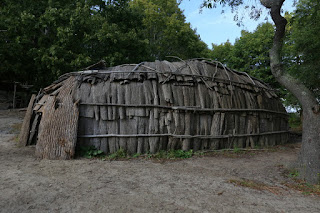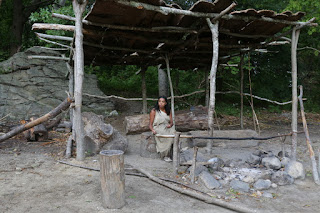Today started out well with a delicious breakfast at Zaftig’s (thank you Michael Giobbe for that great recommendation), a quick stop in a bookshop to buy a copy of Henry James’ The Bostonians (you can’t come to Boston on a history tour and not read that!) and a stop at Trader Joe’s to pick up some breakfast food for the next few days. (The beautiful Longwood Inn has a gorgeous kitchen we can use.) Then we launched out on a day trip to Plymouth to learn about the Pilgrims – what really motivated their journey, what their life was like, how they interacted with the native people, etc.


We started with a tour of Mayflower II, a replica of the original ship the Pilgrims came over on in 1620. They actually first landed on Cape Cod near what is now Provincetown, but they soon moved to Plymouth and made their permanent settlement there. The original Mayflower sailed back to England and ended up in a scrap yard. Not a very illustrious ending for such a famous ship. But she was not a particularly noteworthy vessel at the time, and the name Mayflower was not even unique to her.
We walked further from there and saw the statue of William Bradford, the Governor of Plymouth Colony and documenter of their voyage in his journal Of Plymouth Plantation. Up a flight of steps from there is Cole’s Hill, upon which stands the imposing statue of Massasoit, the Wampanoag leader who “prevented the failure of Plymouth Colony and the almost certain starvation that the Pilgrims faced during the earliest years of the colony's establishment.” Near that is the Pilgrim Sarcophagus which marks the final resting place of those who died in the first year, which was 45 of the original 102 passengers.


As we continued on we saw some of the beautiful old houses, some dating back to the 1700s. Later we would happen to wander past a wood-framed one built in 1640, the oldest house in Plymouth. We walked through a lovely landscaped park called Brewster Gardens where we saw a statue honoring “those intrepid English women whose courage, fortitude and devotion brought a new nation into being.” All of this was alongside Town Brook, the spring-fed brook which was the water source for the Pilgrims.
Next on our itinerary was the Jenney Grist Mill, built and operated in the 1630s-1640s by Colonist John Jenney. It is a reconstruction of the original that burnt down. It is a museum today, but they still operate the mill two days a week and sell the cornmeal ground by it. It can grind 100 pounds an hour! We learned the origin of the phrase “to keep one’s nose to the grindstone”: sometimes, if the grindstones were too close together, the grain between the stones would become too fine a powder and could spontaneously combust, so the operator would need to keep his nose to the grindstone to smell if anything was burning and adjust the gap between the stones. It makes for a good story, even if it’s likely not etymologically accurate.


After a stop for lunch (I got in my first bowl of New England clam chowder!), we headed for Plimoth Plantation, a little bit south of town. On the way we had a special treat: a flock of wild turkeys crossed the road in front of us, bringing to mind the Pilgrims’ legendary first Thanksgiving. We could see that they would definitely have had an abundant supply of turkey!


Plimoth Plantation is a reconstruction of an English colonists’ village with a replica of a Wampanoag village beside it. Costumed actors role-played the colonists and Indians going about their daily activities. As we peered into their houses, we felt sort of voyeuristic. They made themselves available for us to ask questions, but they played dumb if we didn’t enter into their time period. I asked a couple of them if I could take their picture, and they had no idea what I was talking about. They pointed at my funny looking box and the woman said to the man with a quizzical look, “I think she wants us to stand next to each other?” They were all really quite charming and hospitable.


One set of them asked me what was the reason for my visit. I said I was on a pilgrimage. They said, “Oh we’re pilgrims too. What is the purpose of your pilgrimage?” I told them I was seeking to learn more about the history of America. They said, “Ah, well we’re English. I suppose you mean the voyages of the explorers and such. There was some Norse explorer 500 years ago, I hear.” I said “No, I mean the history of this place. I understand a chap called William Bradford wrote about it in his journal.” They said, “Oh yes, he lives right across the way.” (I’d met and chatted with his wife just a few minutes prior.) And they also recommended to me a book called Good News from New England written by one of their fellow colonists. I said I supposed I could find that in a library, but I didn’t imagine they had any libraries around here. They told me that Myles Standish a few doors down had a good personal library, but he wasn’t likely to lend me his private copy. I figured I wouldn’t bother telling them I could probably find a PDF of it on the Internet. They’d never met a geek before and wouldn’t know what to do with one.



No comments:
Post a Comment